November 22, 2019
Air Date: November 22, 2019
FULL SHOW
SEGMENTS

ExxonMobil Fraud Decision Due
View the page for this story
In 2018 the Attorney General of New York State filed a civil suit against multinational oil and gas corporation ExxonMobil, alleging that Exxon defrauded shareholders by using two sets of books to calculate the impact of climate change regulations on its business. At trial in October the company admitted one set of calculations was shared with shareholders and another was used internally for project planning, but said it was legal. A verdict is expected soon from the judge. Nicholas Kusnetz, a reporter for InsideClimate News, joined Host Steve Curwood to discuss the case. (09:59)
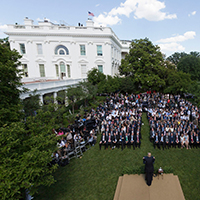
UN Climate Ambition Gap
View the page for this story
Climate negotiators from the world are gathering in Madrid, Spain starting December 2 with challenging items on the agenda. One issue concerns cooperation between developing and developed nations and emissions trading. Another concerns how to handle loss and damage from climate-related disasters. And front ad center is the enormous gap between the present commitments of the 195 nations that are party to the Paris Climate Agreement and what UN scientists say are needed to avoid catastrophic climate disruption. Alden Meyer of the Union of Concerned Scientists discusses with Host Steve Curwood. (09:09)
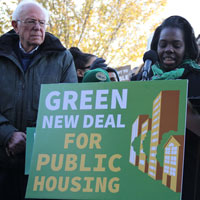
A Public Housing Green New Deal
View the page for this story
Senator Bernie Sanders (D-VT) and New York Representative Alexandria Ocasio-Cortez (D-NY) recently introduced the “Green New Deal for Public Housing Act”. This bill aims to invest $180 billion to upgrade 1.2 million units of federal public housing over a 10-year period through a program that will create jobs, improve public health and reduce carbon emissions. Senator Jeff Merkley (D-OR) spoke with Host Bobby Bascomb about why investments in federal public housing can be win-wins for people and the planet. (08:14)
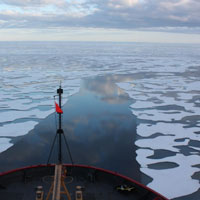
Beyond The Headlines
/ Peter DykstraView the page for this story
In this week’s Beyond the Headlines Peter Dykstra joins Host Bobby Bascomb to take a look at how melting sea ice in the Arctic is already opening up new shipping routes for oil and gas in particular. Then, the two discuss the low attendance by Democratic candidates at the first ever Presidential Forum on Environmental Justice, and some of the big ideas from the candidates who showed up. Looking back at this week in history: the sinking of the Whaleship Essex by a sperm whale, the inspiration for the classic Moby Dick. And looking forward, Peter has an interview date with climate change skeptic Senator Jim Inhofe… in 15 years, when he turns 100. (04:28)
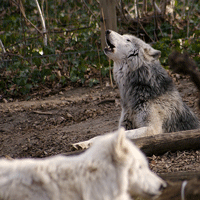
Winter Wolf Song
/ Jennifer JarrettView the page for this story
The last wolf in Yellowstone National Park was killed in 1926, and for decades afterwards, there was silence where once there were otherworldly howls. Now their songs are back, twenty-five years on from their reintroduction, and Jennifer Jarrett brings us this audio postcard from Yellowstone’s wolves. (01:35)
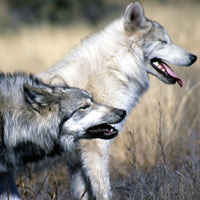
Winter Wolves on the Move
/ Mark Seth LenderView the page for this story
The Lamar Valley is one of the best spots in Yellowstone National Park to see and hear its iconic gray wolves. As the snow begins to fall, they’re on the hunt in this essay from Living on Earth’s Explorer in Residence, Mark Seth Lender. (02:37)

A Tasty Vegan Thanksgiving
View the page for this story
Vegan fare may be healthier for the planet and people than foods based on animal products, but most Americans do prefer a plump turkey on the center stage for Thanksgiving, with buttery mashed potatoes, gravy and pumpkin pie singing backup. Yet among the vegan options there are plenty of tasty selections. Host Bobby Bascomb tasted a sneak preview of a planned vegan Thanksgiving feast at a restaurant in Watertown, Massachusetts. (10:13)
Show Credits and Funders
Show Transcript
HOSTS: Bobby Bascomb, Steve Curwood
GUESTS: Nicholas Kusnetz, Jeff Merkley, Alden Meyer, Pankaj Pradhan
REPORTERS: Peter Dykstra, Mark Seth Lender, Rick McIntyre
[THEME]
CURWOOD: From Public Radio International – this is Living On Earth.
[THEME]
CURWOOD: I’m Steve Curwood.
BASCOMB: And I’m Bobby Bascomb.
As the UN looks to refine the Paris climate agreement the world is lagging behind where we need to be to avoid climate disaster.
MEYER: To get on track to stay below 2 degrees, analysis by the United Nations environment program and others show that we would need to basically triple the level of ambitions of commitments countries have made under Paris.
CURWOOD: Also, some vegan options for when turkey and gravy and pumpkin pie take center stage at Thanksgiving.
PRADHAN: I take vegetables, which has a more meaty textures like mushrooms, lentils. We use, like, big lobster mushroom, it gives very close texture to you having a meat.
CURWOOD: That and more this week on Living on Earth – Stick Around!
[NEWSBREAK MUSIC: Boards Of Canada “Zoetrope” from “In A Beautiful Place Out In The Country” (Warp Records 2000)]
[THEME]
ExxonMobil Fraud Decision Due

Prosecutors say ExxonMobil kept two sets of books on the effects of climate change. (Photo: Mike Mozart, Flickr CC By 2.0)
BASCOMB: From PRI and the Jennifer and Ted Stanley studios at the University of Massachusetts Boston, this is Living on Earth. I’m Bobby Bascomb.
CURWOOD: And I’m Steve Curwood.
The Attorney General of New York State alleges ExxonMobil defrauded its shareholders with a double set of books to calculate the impact of climate change regulations on its business. The NY AG filed a civil suit based on those allegations in 2018 and now the trial that began in October of this year has drawn to a close, with the verdict from the judge yet to come. Nicholas Kusnetz is a reporter for Inside Climate News, and he’s been covering the ExxonMobil trial. He joins us now. Nicholas, welcome back to Living on Earth!
KUSNETZ: Hi, it's good to be here.
CURWOOD: So, we've been covering this trial off and on since it began, but for those who aren't in the know, just quickly give us some backstory of this lawsuit.
KUSNETZ: Sure. So the lawsuit, which was filed about a year ago, came after years of investigation by New York's Attorney General into Exxon, and its practices about climate change, and what it knew and what it was saying publicly. There wasn't a ton known about what exactly was being investigated. But all of this came after reports by my organization, Inside Climate News, and also the Los Angeles Times, that looked into what Exxon knew about climate change decades ago and the science that it was funding that was showing the danger of the products that Exxon produces themselves, and the huge impact they could have on global warming.
CURWOOD: Now, how would investors have been damaged by this alleged fraud by Exxon?
KUSNETZ: So one thing to point out is: it's not about sort of, you know, the hashtag of "What Exxon Knew". The case focuses on something a little different. Really, it's a securities fraud case. The allegations are that Exxon was telling investors, essentially, that it was taking climate change much more seriously. And assuming that governments would take more action to limit emissions, while internally, it was assuming that regulation would be more limited. So that figure that it was using internally was significantly lower than what it used externally. In some cases, it actually didn't apply a cost estimate at all.
CURWOOD: And what risk was the company running by doing this?
KUSNETZ: So, the Attorney General's Office actually likened it to an insurance policy, essentially. So, the idea being that Exxon was telling investors it was taking out this big insurance policy against these regulations, when in fact it actually was not. One important effect that this had is it gave the company less incentive to shift away from high emissions projects. And in fact, there's internal emails that the Attorney General came across and its investigation that had people at Exxon talking about the two different costs and saying, okay, well, the high cost provides more incentive to invest in things like a carbon capture project, anything that cuts emissions, really. The lower cost provides less incentive for that, and of course, more incentive to continue to invest in big projects that have really high greenhouse gas emissions.
CURWOOD: And higher profits, I would imagine.
KUSNETZ: As it happens, yes.
CURWOOD: And so, if you're an employee inside Exxon, you don't want to bring the bad news to your bosses, it sounds like. You're going to go with the lower estimate, I would think.
KUSNETZ: Well, one important thing to note is that there's no dispute on the core fact that Exxon had two separate estimates. What Exxon has said is they were used for different purposes, and we had good reason to use different estimates. One of them, which they called the proxy cost, this was what they disclose to investors. They use this to model demand for oil and gas far into the future. And so that, of course, has an impact on the prices that they'll receive. The other cost estimate that we use, and this was the internal lower one, they said, we were just looking at what our own projects are going to have to pay. So this would be a direct cost on refineries, say in Texas. And so Exxon has said we had good reason for these to be different.
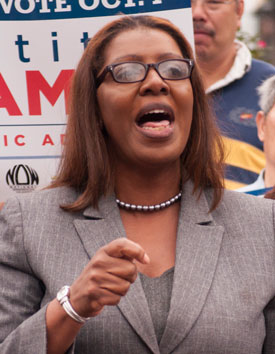
Letitia James is the current Attorney General for the state of New York and inherited this case against ExxonMobil from former NY AG Eric Schneiderman. (Photo: Matthew Cohen, Wikimedia Commons, CC BY 2.0)
CURWOOD: Well, that sounds realistic. So, what did the Attorney General say to pierce that bubble, to say that that's not reasonable?
KUSNETZ: The Attorney General's case is really revolving around an argument that it doesn't really matter which was right or wrong. It's not a question of what price Exxon should have put on carbon at what time. It's all about what they were telling investors. And what the attorney general has said is you have to be honest with investors, and they claim Exxon wasn't because Exxon never disclosed this lower internal cost to investors, and its own executives on the stand actually pointed to only one sentence in one report where it disclosed even the existence of this other cost. And if you read the paragraph that it's in, it's really not entirely clear that they're talking about two separate things. And, in fact, this is what a lot of the case focused on, was not these bigger questions of climate change and emissions, but on what an investor should or should not have understood from reading the company's disclosures, and whether this one-sentence disclosure is adequate.
CURWOOD: And in a gross sense, if there are two different sets of books that raises the question of well, which one is real?
KUSNETZ: Sure. And this is something that Exxon's lawyers pushed on a lot because, you know, they said, and it's true, this is all speculative. No one knows what emissions will be two years from now, let alone 10 or 20 or 30 years from now, and so Exxon has said this is all speculative, and we were just doing our best and you can't punish a company for that. But again, what the Attorney General has said is the point is not whether one is right and one is wrong. The point is whether you're being honest with investors about how you're running your business.
CURWOOD: Now, as I understand it, as the testimony phase of the trial was wrapping up, there were two counts of fraud that were withdrawn by the state. What were those charges, and what are the charges still standing for the judge to consider?
KUSNETZ: Yeah, the Attorney General's Office dropped two claims at the last minute, really, in the midst of its closing argument. And the claims that dropped would have required the Attorney General to prove that Exxon and executives knew what they were doing; that they intentionally misled investors. The remaining charges however, the Attorney General only needs to prove that Exxon did in fact mislead investors. It doesn't matter whether it was intending to do so.
CURWOOD: Let's look ahead, what might the penalties be for Exxon if it were to lose this case?
KUSNETZ: So the judge has a few options. If he does decide to rule against Exxon, he could impose fines. And while it's ultimately up to him what that fine would be, the Attorney General's Office has presented a number that it says investors essentially overpaid for Exxon stock as a result of this fraud. And that ranges from $476 million to $1.6 billion. So the judge could impose a fine, you know, using that as a guide or not, but the judge could also simply order Exxon to correct its disclosures. This is something else that the Attorney General has asked for, to issue corrective disclosures essentially, for the court to oversee new reports and disclosures to investors that would be more straightforward about how it's applying these cost estimates for carbon.
CURWOOD: And if Exxon wins this case, what might happen then?
KUSNETZ: If Exxon wins the case, I mean, I think it would certainly be a significant blow to any similar type of lawsuit. Massachusetts recently filed a lawsuit based in part on some of the same evidence and some of the same reasoning. There are also some other shareholder lawsuits, class action suits against the company along similar lines. New York, because of the way the state law is, had particularly broad powers to investigate, and there's a lower burden of proof than many other state laws to get a ruling in favor of the Attorney General. So it would be a big blow to those. I mean, more broadly, Exxon and other major oil and gas companies face more than a dozen major climate change lawsuits. They're kind of different in nature. But this case would surely get cited in those by either side, you know, whoever wins.

Nicholas Kusnetz is a reporter for Inside Climate News. (Photo: Courtesy of Inside Climate News)
CURWOOD: So, Nick, to what extent did the Attorney General make the case that this knowledge was material for investors?
KUSNETZ: So this is an important point, the judge's ruling could end up hinging entirely on this question of what you said, you know. Material is the key word. It's not enough for Exxon to just have misled investors to violate this law. It has to be that what Exxon was misleading them about was actually important to investors, that it's the kind of thing that would have led someone to buy or sell a stock, for example. And so a lot of the trial centered on this question. What the Attorney General pointed to a lot is the sort of unquestionable evidence that the investment community, broadly speaking, sees climate change as a huge risk, and in particular, for oil and gas companies as a major risk. And they pointed to their own evidence, you know, one analyst, for example, who did pick up on a little detail on the case, but this question of whether investors actually cared is going to be central to whatever the judge decides.
CURWOOD: And so if the judge decides that investors did care, then they must have lost money.
KUSNETZ: Well, then that's a third step. So, in order for the judge to issue a fine, make Exxon pay, then yes, investors had to have lost money and the Attorney General has to prove that. But even if the Attorney General is unable to prove that piece of it, and there is no fine, the judge could still say that the company violated the law and issue a sort of order for it to change its disclosures, for example, simply based on the fact that it was misleading investors about an important piece of information.
CURWOOD: Nicholas Kuznetz is a reporter for Inside Climate News. Nick, thanks so much for taking the time with us today.
KUSNETZ: Yeah, thank you for having me on the show.
Related links:
- Click here to read Nicholas Kusnetz’s coverage of the trial
- Forbes | “New York Goes Out With A Whimper In Its Case Against ExxonMobil”
- Climate Liability News | “Exxon Opens Defense in New York Climate Fraud Trial”
[MUSIC: New Interplay Trio, “Autumn Leaves” on The First Conversation With Myself, by Johnny Mercer/Jacques Andre Marie Prevert/Joseph Kosma, Buena Suerte sas/EMI Music Publishing]
BASCOMB: Coming up – Democrats in congress propose a green new deal for public housing. That’s just ahead on Living on Earth.
ANNOUNCER: Support for Living on Earth comes from Sailors for the Sea and Oceana. Helping boaters race clean, sail green and protect the seas they love. More information at sailors for the sea dot org.
[CUTAWAY MUSIC: New Interplay Trio, “Autumn Leaves” on The First Conversation With Myself, by Johnny Mercer/Jacques Andre Marie Prevert/Joseph Kosma, Buena Suerte sas/EMI Music Publishing]
UN Climate Ambition Gap
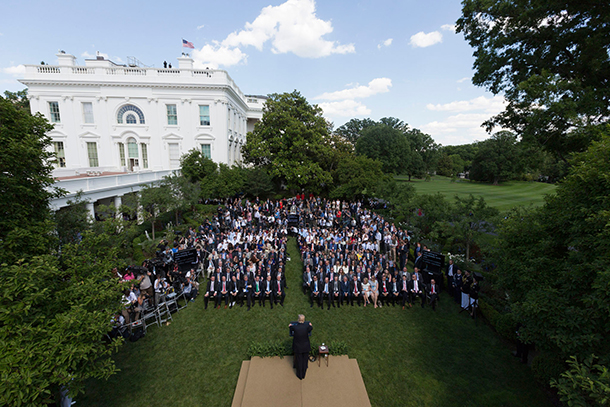
President Trump addressed a crowd in the Rose Garden on June 1st, 2017, when he announced he would withdraw the United States from the Paris Agreement on climate change. (Photo: Official White House Photo by Joyce N. Boghosian)
BASCOMB: It’s Living on Earth. I’m Bobby Bascomb.
CURWOOD: And I’m Steve Curwood.
At the beginning of December UN negotiators will move to advance the Paris Climate Agreement in a meeting that was hastily shifted to Madrid, Spain in the face of civil unrest in its originally planned site, Santiago, Chile. Earlier this month President Trump officially set in motion the withdrawal of the United States from the accord, though it won’t take effect until the day after the 2020 US presidential elections. And though every other nation is still in the Paris agreement, less than a handful have made pledges that would have a chance of keeping the planet from catastrophically overheating. Alden Meyer, Director of Strategy and Policy for the Union of Concerned Scientists, is here to explain. Welcome back to Living on Earth, Alden!
MEYER: Good to be with you again, Steve.
CURWOOD: Alden, I keep hearing that the Paris process is far behind what's needed. What exactly are the numbers at this point, what have nations committed to and what's the gap for what many would say is necessary?
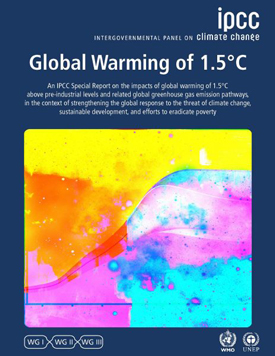
In October 2018 the Intergovernmental Panel on Climate Change released a Special Report on the impacts of global warming of 1.5°C above pre-industrial levels. Its dire warnings drew the world’s attention. (Photo: IPCC)
MEYER: Well, basically, you'll recall that leaders set a goal of keeping the temperature increase above pre-industrial levels well below two degrees Celsius, that's 3.6 degrees Fahrenheit for those keeping score at home, and trying to get as close to 1.5 degrees Celsius as possible. Analyses vary a little bit, but they tend to say that we're on track for around three degrees Celsius or more. That may not seem like a huge difference, but the Intergovernmental Panel on Climate Change report last year on 1.5 degrees show that there's a huge difference even between 1.5 and two degrees Celsius. Every 10th of a degree matters. And to get on track to stay below two degrees analysis by the United Nations Environment Programme and others show that we would need to basically triple the level of ambition of commitments that countries have made under Paris. To have a chance of getting anywhere close to limiting temperature increase to 1.5 degrees, we would need to quintuple, in other words increase by five fold, the level of ambition in Paris. So what's needed here is not incremental changes around the margins. It's really a wholesale transformation, getting on the path to cutting emissions nearly in half by 2030 globally, and to net zero emissions no later than 2050. It basically involves remaking almost every sector of the modern economy.
CURWOOD: And, of course, the process, the UN negotiation process continues; the Conference of the Parties, the UN umbrella for the Paris accord, on December 2, the annual meeting of that starts in Madrid, what needs to be done at that session?
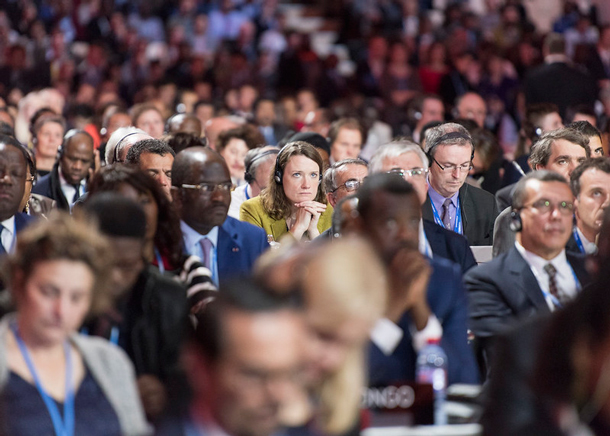
A shot from the “Comité de Paris”: Presentation of Draft Outcome Document at the UN Climate Change Conference in Paris (COP21) in 2015. (Photo: Mark Garten / United Nations, Flickr CC BY-NC-ND 2.0)
MEYER: Well, there's a few issues on the formal negotiating table that have to be resolved. The one unfinished piece of business from the last climate summit in Poland last fall was completing the part of the Paris Agreement calling for collaborative approaches to emission reductions: emissions trading, cooperation between developed and developing countries. It's the so-called Article Six of the Paris Agreement. It's both a very political issue and very technical, and you put those two factors together, it makes it difficult for countries to resolve their differences. The other major issue on the table is what's known as loss and damage, which is the unavoidable impacts now of climate change on vulnerable countries around the world. After they've done everything they can to reduce their emissions, everything they can to build in resilience measures to their economy, there are still going to be sudden impacts such as typhoons and hurricanes and floods and what's called slow-onset impacts such as sea level rise, desertification, drought, etc. They need help dealing with that. And the deal in Paris was to set up a program to help countries cope with those now unavoidable impacts. The missing piece so far has been any substantially ramped up finance and capacity-building support for those countries, that will be the issue debated in Madrid, whether there should be an effort to look at innovative sources of finance above and beyond the famous $100 billion pledge the developed countries made a decade ago in Copenhagen for developing country action. Those are the two big negotiating issues. There's some other ones on the table. But looming over it all is this gap that we talked about earlier between the commitments that countries have made under Paris to constrain their emissions, and what's needed to meet the science-based temperature limitation targets. And that will be permeating the conversation; there will be a number of high level ministerial meetings, not just the usual environment ministers that come together at these things, but the Chileans are also convening meetings of science ministers, energy ministers, finance ministers, agriculture ministers, because this is going to take everyone in every sector of the economy pulling together. And they want to stimulate a race to the top and in terms of increasing ambition. So that'll be the sort of subtext of this meeting. And all of this is laying the groundwork for the climate summit next November, just after the US elections that the United Kingdom will be hosting in Glasgow, Scotland, which is the real deadline under Paris for countries to say, Is this your final answer? What you put forward five years ago in Paris and in terms of your level of ambition, or can you do more? That's the real political deadline for countries to decide what to do on the ambition front. So in a sense, this COP in Madrid will just be sort of setting the table for that much deeper, more intense conversation over the course of 2020.
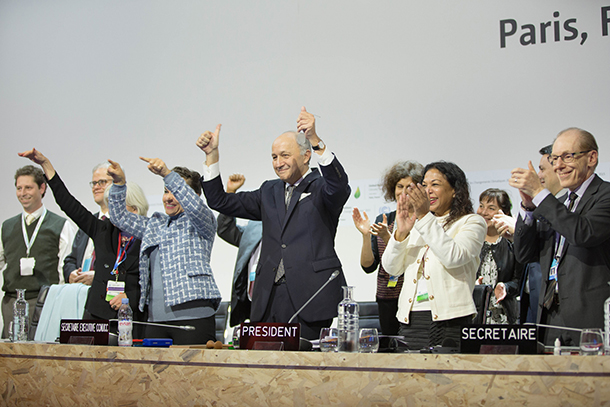
UN climate change leaders shared a moment of joy at the establishment of the landmark international climate agreement in Paris, France, December 12, 2015. Including the U.S., which has begun the yearlong withdrawal process, 194 states and the European Union have signed onto the agreement. (Photo: UNclimatechange, Flickr CC BY 2.0)
CURWOOD: So to what extent is the upcoming meeting providing a reality check to the world about the amount of money that is going to be required to make the kind of transformations that will, you know, keep the planet from becoming relatively uninhabitable?
MEYER: Well, that's definitely part of the conversation. And as you know, huge sums of money are involved here, not only the public sector money, such as the hundred billion dollar commitment that was made, starting in 2020 per year from developed to developing countries, but the much larger trillions of dollars of investment per year that are being made in the private sector. And there's a whole movement called Shifting the Trillions, which says we have to redirect the money that's now going into fossil fuel investments and coal and oil and natural gas infrastructure around the world, redirect that into efficiency, into renewable energy, into nature-based solutions like agriculture and wetlands and forest solutions if we're going to have any hope of getting ahead of this curve. The good news, of course, is that it's much less costly to do that, than to sit by idly and watch climate impacts mount. I think it's coming home to people that the cost of climate inaction is really the threat to well-being and global prosperity, not the cost of climate action.
CURWOOD: And remind us, Alden, of the We're Still In movement in the United States that the governors, leaders of cities, and a number of companies have come together to come to the international meeting to say that, despite the reluctance of the White House to engage, that there are many other jurisdictions in the US that are.
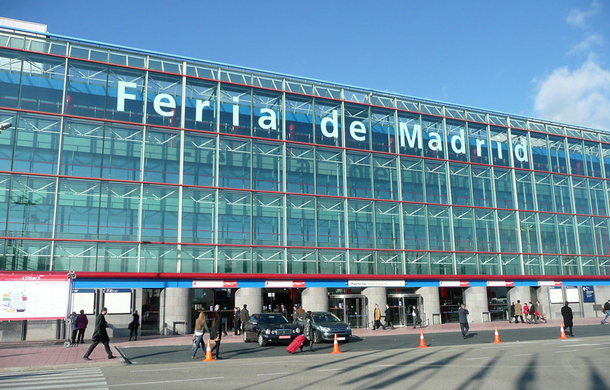
The COP25 climate change meeting is scheduled for Dec 2 –13 at the IFEMA convention center in Madrid, Spain. (Photo: Alquiler de Coches, Flickr CC BY 2.0)
MEYER: Well, this is a movement that was launched in the wake of the elections in 2016, actually had its origins in the Marrakech Climate Summit, which took place during the US elections. And as you said, a number of governors, mayors, business leaders, university presidents, investment leaders and others have come together to say to the world that President Trump does not equal America when it comes to climate change. That there are substantial elements of the US political system, US economy, that are committed to Paris, committed to do our share of reducing emissions. With the election of a number of new governors last November, there are now, I believe, 25 or 26 states in the US climate Alliance, which is the state-based component of We Are Still In. And collectively the states and cities that are in the We Are Still In movement represent about two thirds of the American economy and the American population. So this is a big coalition of folks; they will have a presence in Madrid, there will be a US Climate Action Center, which will feature side events and press briefings, and exhibitions and talks by these leaders from around the United States, trying to show the rest of the world that despite what President Trump is doing, formally starting the withdrawal process from Paris, that most Americans and most sub-national leaders remain committed. And of course they have the public behind their back, because all the public opinion polling shows a very substantial majority, not just of all Americans, but of Republicans as well support the US staying in Paris, support us being a leader on climate. So in a sense, they're just trying to demonstrate that President Trump is an aberration.
CURWOOD: Alden Meyer is Director of Strategy and Policy at the Union of Concerned Scientists. Thanks so much, Alden.
MEYER: I enjoyed being with you, Steve.
Related links:
- Read the IPCC’s Special Report, “Global Warming of 1.5 °C”
- Hear Living on Earth’s interview about the COP24 UN climate meeting in Katowice, Poland in December 2018
- LOE’s coverage of the IPCC 1.5 °C Special Report
- See the agenda and more for COP25 in Madrid, Spain
- About the Union of Concerned Scientists
[MUSIC: Stephane Grappelli, “Stardust – take 1” on Stardust (The Full Album), by Hoagy Carmichael, 1201]
A Public Housing Green New Deal

During the announcement of the Green New Deal for public housing legislation with Sen. Bernie Sanders (D-VT) (left) , Kari Fulton from the Climate Justice Alliance stated that 70% of public housing in America is within one mile of a superfund site. (Photo: Jackie Filson, Flickr, CC BY-NC-SA 2.0)
BASCOMB: The affordable housing shortage is a growing problem in many parts of the US, and even some middle-class families have to make hard choices. But for the poor, the lack of affordable housing has become a crisis. There are about 11 million extremely low-income households in the US these days and many of the 1.2 million federal public housing units are so badly run-down residents can go for weeks without adequate water or heat. To address the federal public housing emergency and at the same time create jobs, Democrats in Congress are proposing $180 billion for a Public Housing Green New Deal. It would also lower greenhouse gas emissions and help align the US with the Paris Climate Accord, as buildings account for roughly one third of all US emissions. Senator Bernie Sanders from Vermont and Representative Alexandria Ocasio Cortez from New York filed the bill, along with 95 other Democrats as co-sponsors, including Senator Jeff Merkley of Oregon, who joins us now. Senator Merkley, welcome to Living on Earth!
MERKLEY: Thank you so much good to be with you.
BASCOMB: So what are the current problems with public housing in the United States?
MERKLEY: Well, we don't have nearly enough public housing for one. The result is that so many families are paying way too high a percentage of their income for housing, so we need to greatly expand the supply. But we also need to take that housing stock and proceed to make it far more energy efficient, and to have the energy that goes into the building be renewable energy and the result of that is a lot of saving on energy costs down the road, a much more comfortable place to be and, and a lot of help in terms of taking on climate chaos, by decarbonizing the operation of these homes.

Sen. Bernie Sanders (D-VT) and Cong. Alexandria Ocasio-Cortez (D-NY) are co-sponsors of The Green New Deal Bill for Public Housing. It would invest in energy efficient infrastructure in federally owned homes and provide job opportunities for residents. (Photo: Jackie Filson, Flickr, CC BY-NC-SA 2.0)
BASCOMB: And how would this bill address those problems?
MERKLEY: Well, it does it in a variety of ways. One is to take and electrify the homes, so you can imagine a gas furnace becoming a heat pump, having the electricity that flows into the house come from renewable sources, changing the lighting. Proceeding to do a lot of efficiency upgrades so the homes need a lot less energy in the beginning. Putting solar panels on the roof or perhaps canopy, solar canopies over the parking lots. So those are the main types of ideas that would go into this.
BASCOMB: Now I understand this bill would be the first example of turning broad goals discussed in that Green New Deal into some specific policies. How do you see that developing?
MERKLEY: Well, I think it's exciting. The vision of The Green New Deal on the environment looks at some basic principles. One is that the carbon pollution in the air is causing all kinds of trouble, and we need to address it very urgently. And then, in addition, while addressing it, we can create millions of good paying jobs, and we can make sure a lot of those jobs go to places that have been bypassed previously. Places like frontline urban communities, former fossil fuel communities, rural and frontier communities. And so that's the vision: big challenge, robust response, create jobs, help get those jobs where they're most needed.
BASCOMB: And to what degree do you see this problem with public housing as an environmental justice issue?
MERKLEY: Oh, it's very much environmental justice, because a lot of these are in inner city communities that suffer from a greater concentration of pollutants, maybe from old materials that are in the homes themselves. And the idea here is that the residents would be able to be employed in this operation. So a better place to live a better community, and more job provision for that community. So it's a win on several fronts.

New York City’s public housing has a deferred maintenance crisis, with $17 billion in backlogged repairs. (Photo: Dan DeLuca, Flickr, CC BY-2.0)
BASCOMB: What kinds of jobs are we talking about with them?
MERKLEY: Well, one thing I'm excited about is that a lot of these jobs would be union jobs with good benefits so workers have earned enough to, to live on. Jobs for renovating homes so you're adding insulation or you're installing double paned windows, possibly jobs actually doing some of the infrastructure on replacing water heaters or furnace systems, those types of jobs; also jobs where people are trying to install solar panels.
BASCOMB: Well, I mean, it seems like a good investment but nonetheless expensive. How do you intend to pay for it in the long term?
MERKLEY: Well, the legislation invests a lot, it's $180 billion. A lot of that needs to be invested, upgrade these public homes, these million homes anyway, because you can't sustain a housing stock without continuing to invest in the repair and upkeep. You have to replace furnaces every so often, you have to replace water heaters every so often. You need to improve energy efficiency with the windows and insulation and when you do that you save on the energy costs so that gets repaid. So I feel like this is a very good investment. But none of the materials are made overseas and virtually everything's made in the United States. And if the jobs also go to the communities where the housing is, that's a very strong and if the energy savings helps pay for the energy efficiency upgrades, then that's a real win.
BASCOMB: So if you have to do these repairs anyway, you might as well do them in a way that's, you know, forward thinking.
MERKLEY: If you're replacing a gas furnace, are you going to replace it with another gas furnace, or are you going to replace it with a heat pump?
BASCOMB: Right.
MERKLEY: And I'd like to think you'd replace it with a heat pump. And I want to encourage all your listeners to think about this in terms of your house. If you have a gas hot water heater, you can change it to electric hot water heater, if you have a gas or oil furnace, you can install a heat pump. You can change your light bulbs, you can insulate your house, and in doing these things, you make a huge impact on your carbon footprint on your home. And these are the types of things I've been doing with my home out in Oregon because it's just something that the individual can take action on. In this case, we're talking about a million homes where the residents don't own the homes. The decision has to be made by the owner of the homes, that is, the government, the federal government needs to upgrade these homes.
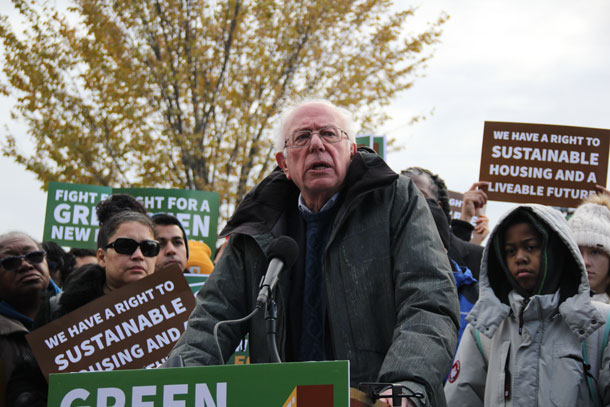
This bill is aimed at reducing public housing costs by 30% and energy consumption costs in public housing by 70%. (Photo: Jackie Filson, Flickr, CC BY-NC-SA 2.0)
BASCOMB: Now, New York has the nation's largest housing agency, but faces deferred maintenance costs. And then there's states like California and Illinois that also have a lot of problems administering public housing. What kind of challenges do you currently see in the state of Oregon?
MERKLEY: When I think about Oregon right now, you know, people think Oregon and they go, hey, I'd like to live there! Because they've heard it's paradise and it is paradise, except it doesn't have enough affordable housing. So we've had for years the one way U-Haul statistics have shown that Oregon is one of the top destinations, normally first or second out of the 50 states for people to just say let's, let's move there. But if they move there and there's no housing, that is a big problem. And we have seen that when housing is developed the commercial sector that housing is aimed at high income folks moving into the state. So we need to build a lot more housing for low income families and middle income families.
BASCOMB: Well, politically, how does this move forward at this point?
MERKLEY: Well, you start by putting out the vision. And then you start building support. I don't anticipate that it is likely that this program can move forward under Republican leadership of the Senate, because their big goal was to do tax breaks for the richest people in America and that's what they did in 2017. So they spent $2 trillion on the richest families making them richer. Well, I think it's going to take American citizens saying that's crazy, look, look the richest people don't need our help. Who needs our help are our fundamental low income and working families trying to have a decent home and a decent community. That's where we should be putting our resources. So I hope to see that attitude dominate when a new Congress comes in.
BASCOMB: Oregon, Senator Jeff Merkley. Thank you so much for taking this time with me.
MERKLEY: Oh, thank you. I'm so glad you're covering this topic. This is very important to our future.
Related links:
- The Washington Post | “Ocasio-Cortez, Sanders Pitch Green New Deal Bill for Public Housing”
- The Guardian News | “Video of Bernie Sanders and Alexandria Ocasio-Cortez Announcing Legislation”
[MUSIC: Bela Fleck/Zakir Hussain/Edgar Meyer & The Detroit Symphony Orchestra/Leonard Slatkin, “Bubbles” on Melody of Rhythm]
CURWOOD: Coming up- winter comes to the wolf packs in Yellowstone national park. That’s just ahead on Living on Earth.
ANNOUNCER: Funding for Living on Earth comes from you, our listeners, and United Technologies, combining passion for science with engineering to create solutions designed for sustainability in aerospace, building industries, and food refrigeration. UTC companies such as Otis, Carrier, Pratt and Whitney, and UTC Aerospace systems are helping to move the world forward. You can learn more about United Technologies by tuning into the Race to Nine Billion podcast; listen at racetoninebillion.com. This is PRI, Public Radio International.
[CUTAWAY MUSIC: Bela Fleck/Zakir Hussain/Edgar Meyer & The Detroit Symphony Orchestra/Leonard Slatkin, “Bubbles” on Melody of Rhythm]
Beyond The Headlines
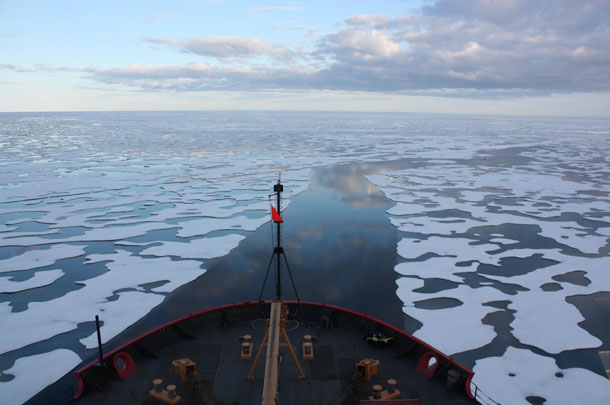
A channel through Arctic sea ice. (Photo: Kathryn Hansen, NASA, Flickr, CC BY 2.0)
CURWOOD: It’s Living on Earth, I’m Steve Curwood.
BASCOMB: And I’m Bobby Bascomb and it’s time for a trip now Beyond the Headlines with Peter Dykstra. Peter is an editor with Environmental Health News, that’s EHN.ORG and DailyClimate.org. Hey there, Peter, what do you have for us this week?
DYKSTRA: Hi, Bobby. I've got news for the Arctic and I'm afraid none of it is very good. Shipping on the Northern Sea Route, that's the Northeast Passage through the melting channels north of Russia, increased in just a year by 63%. It is both quicker and cheaper to go through the melting Arctic, if you're shipping stuff back and forth between Asia and Europe than it is to go through the Mediterranean and the Suez Canal and everything else.
BASCOMB: And I'm going to guess that a lot of that traffic up there isn't tourists but there's a lot of oil and natural gas to be had in the melting Arctic.
DYKSTRA: That's the thing, a lot of the local traffic has to do with the build-up by Russia of the oil and gas industry, both offshore in the melting Arctic and onshore in Siberia.
BASCOMB: Mm hmm, right. So that's just going to lead to a feedback loop here of more melting means more shipping traffic, which means more oil, which means more melting.
DYKSTRA: Scientists would call it a feedback loop. The rest of us would call it just the worst irony in the world.
BASCOMB: Well, another problem I've been reading a lot about is the, the melting permafrost releasing things that have been frozen in it for you know, tens of thousands of years.
DYKSTRA: Yeah, frozen possibly for millennia. There was a case in 2016, in a Siberian village, of an outbreak of anthrax in which one young boy died and Pacific seals and sea lions are beginning to suffer from diseases like distemper, all of a sudden it's showing up in the North Pacific, scientists predicted that this would be one of the consequences of a melting Arctic as the vectors to bring diseases from one place to another begin to open up.
BASCOMB: Oh man. Wow, there's no shortage of problems from such a remote area that probably many of us don't even think about too often. Well, what else do you have for us this week?
DYKSTRA: Not from a remote area, but from South Carolina right here in the United States. Amid all of the polls and all the debates, and all of the crowd of presidential candidates running on the Democratic side, most of the candidates actually passed on an opportunity to reach a crucial audience in a crucial state like South Carolina, the audience, African American voters, the issue environmental justice.
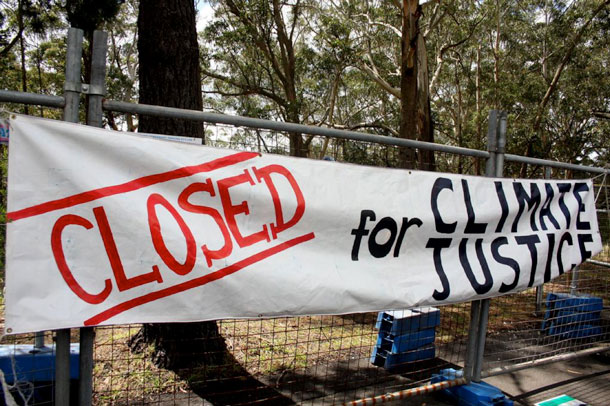
Understanding the effect of climate change on historically marginalized communities is an important aspect of environmental justice (Photo: Climate Camp, Flickr, CC BY 2.0)
BASCOMB: Hmm, most of them passed. Well, who did turn up?
DYKSTRA: The only supposed front runner was Elizabeth Warren. Others included Senator Cory Booker, the billionaire Tom Steyer, and three people that I had totally forgotten were even still running. Former Congressman John Delaney, former Congressman Joe Sestak, and the writer Marianne Williamson.
BASCOMB: Well did anything significant come out of the forum, given the people that were there?
DYKSTRA: There was a lot of dialogue about climate change and its disproportionate impacts expected in poor and minority communities. There was a lot of discussion about urban populations and specific health risks, like the Flint water crisis.
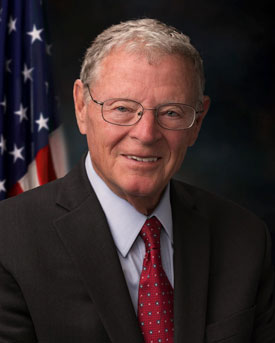
Senator Jim Inhofe (R-OK), a sprightly 85 (Photo: Courtesy of the US Senate)
BASCOMB: Well, what do you have for us from the history vault this week?
DYKSTRA: November 20, 1820, the whale ship Essex was rammed by an enormous sperm whale. It sank. Only eight of the 21 crew survived. They were marooned on a Pacific island for about six months before they were rescued. And about 30 years later, the stories filtered down to a writer who was also an ex-whaleboat crewman named Herman Melville. He based his novel Moby Dick on all the survivors stories, and that's the classic that we know today. And I've got one more thing for you. Last Sunday, Senator Jim Inhofe, the Alpha Dog of climate denial in American politics turned 85 and I proposed to him that we have an interview when he lives to be 100, and he accepted my interview request. The day Jim Inhofe turns 100 we're going to have a really good discussion about the hoax that he says all of climate change is.
BASCOMB: Oh man. Well, congratulations on scoring that interview even if it is 15 years out.
DYKSTRA: I'll have plenty of time to prepare.
BASCOMB: All right, Peter. Peter Dykstra is an editor with environmental health news. That's EHN.org and dailyclimate.org. Thanks, Peter. We'll talk to you again real soon.
DYKSTRA: All right, Bobby, thanks a lot. Talk to you soon.
BASCOMB: And there's more on these stories on our website LOE.ORG
Related links:
- Vox | "Melting permafrost in the Arctic is unlocking diseases and warping the landscape"
- The Guardian | "Pacific seals at risk as Arctic ice melt lets deadly disease spread from Atlantic"
- Read more about what happened at the Presidential Forum on Environmental Justice
- Click here to watch the forum
- Read more about the tragedy of the Whaleship Essex
[MUSIC: Country Joe MacDonald, “Save the Whales” on Classics, Fantasy/ARESA/BMI]
Winter Wolf Song

A pack of gray wolves howling in their habitat (Photo: F.Svehla, Flickr CC BY 2.0)
CURWOOD: As winter settles in we head to Yellowstone National Park with an audio postcard produced by Jennifer Jarret.
MCINTYRE: I’m Rick McIntyre. I work for the park service in Yellowstone National Park, and my title is Biological Technician.
[WOLVES HOWLING]
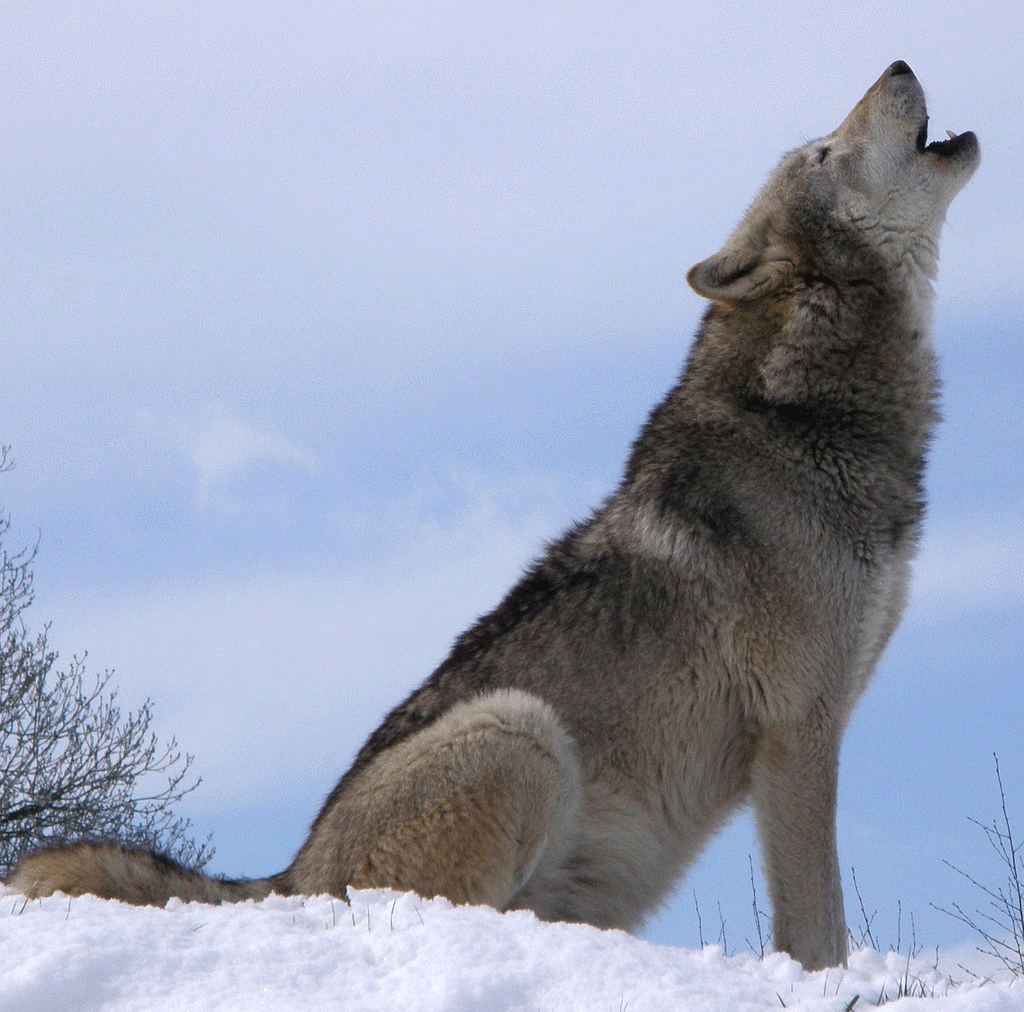
The beautiful howling is a reflection of his beautiful pose (Photo: Retron, Wikimedia Commons)
MCINTYRE: One of things that I often think about when we hear wolves howling is...I’m sure you know the story...that it was the last of the original Yellowstone wolves that were killed in 1926 about a half a mile from where we’re standing. And so for any visitor that had come to Yellowstone from 1926 to 1995 when wolves were brought back and re-introduced and re-established...I’m sure they had a great experience visiting the world’s first national park and they would have seen a lot of great stuff, but there’s one thing they missed out on. There would have been an unnatural silence here.
[SILENCE]
But luckily we realized what a big mistake that was and figured out how to rectify it. So we’re experiencing that right now. That silence is over.
[WOLVES HOWLING]
Related link:
How Wolves Change Rivers
Winter Wolves on the Move
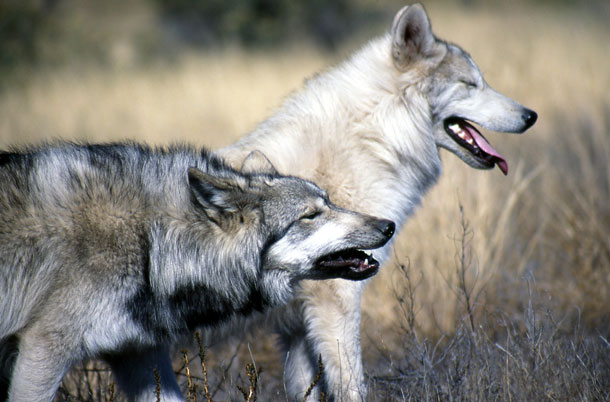
Since gray wolves hunt in packs, they are able to take down prey as large as elks. (Photo: Caninest, Flickr, Public Domain)
CURWOOD: Living on Earth’s explorer in residence Mark Seth Lender headed out into the snows of Yellowstone to see and hear the wolves for himself.
The Sporting Life
Grey Wolves, Lamar Valley
© 2017 Mark Seth Lender
All Rights Reserved.
Leaping and loping, tongues lolling, the snow falling, their great paws snow plowing, down the slope they come. Toward the level ground. Down, and down. They are early. The sun hidden below the mountains. The snow blue. The sky blue black. The stillness pure, white. Down. And down.
Trotting now in their dog-like way along the bank they go. Above where the river flows. Past where elk have nibbled the alder to a stubble, and the land in a blanket of winter ten feet deep.
The river is iced over. It is a bridge across the valley they do not cross but turn, to the westward and the low hills, away from the frozen flow.
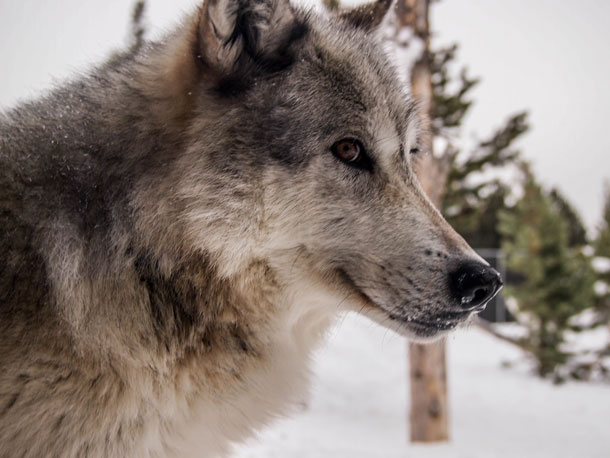
An American Gray wolf in West Yellowstone, Montana. (Photo: Patrick Carlson, Flickr, CC BY-NC 2.0)
And are hidden...
And appear again...
And into the rolling contours of the land - and gone:
Grey wolves, hunting!
The next day beside the ice where the wolves where last seen, an elk stands by himself, antlers five feet across, his lines, his stature; he could be cast in bronze. Except that he moves. He turns his head and looks at the hind part of him, at what the wolves have done to him.
The pack lolls nearby. They are in a hollow just above the river. Sleeping and waking and stretching, and going back to sleep. They imply no desire to do anything else. But in their winter-thick coats in an hour the sun becomes uncomfortable and they mill about, and on some indiscernible signal begin to howl, all together, confirming to each other their order and unity. A young wolf in need of additional teaching is nipped and knocked over and he yelps and cries but is unharmed. And the wolves leave.
They have no intention of finishing what they started. Which does not enhance their reputation. But they cannot help it. The consequence of too many elk there for the taking.
They are too much like us for their own good.
CURWOOD: Living on Earth’s Mark Seth Lender. Our wolf sounds from Yellowstone were produced by Jennifer Jarret.
Related links:
- Visit Mark Seth Lender’s website
- Learn more about the American Gray Wolf
[MUSIC: Warren Zevon, “Werewolves of London” Rhino Records]
A Tasty Vegan Thanksgiving

Chimichurri seitan, Red Lentil’s vegan answer to steak and mashed potatoes. (Photo: Bobby Bascomb)
BASCOMB: As consumers one of the best things we can do to keep our waistlines and our environmental footprints in check is to eat lower on the food chain. Most Americans are choosing to do that, with 60% eating at least one plant based meal per day. Eating less meat reduces personal carbon and has a number of health benefits, including lowering the risk of certain cancers, diabetes and heart disease. But it’s nearly Thanksgiving and for most Americans that means just one thing: turkey, along with the usual sides of mashed potatoes and gravy, stuffing, and pumpkin pie. And for the five percent or so of Americans who are strict vegans and avoid all animal products they have to make different choices for the Thanksgiving feast. So, for the last 10 years Pankaj Pradhan, chef and owner of the Red Lentil restaurant in Watertown, Massachusetts has been preparing a vegan Thanksgiving dinner for his customers. I went to Red Lentil to get a sneak peek at the menu and some vegan advice for Thanksgiving.
[KITCHEN SOUNDS]
BASCOMB: Pankaj is originally from India, where cows are sacred and has been a lifelong vegetarian. He moved to Boston in 2000 and eventually opened a vegan restaurant. Today Pankaj walks up and down his long narrow kitchen collecting the ingredients he’ll need to make a couple sample vegan dishes.
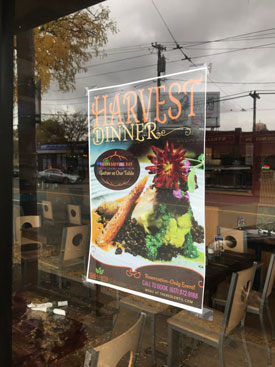
A flyer for Red Lentil’s 5-course vegan harvest dinner. (Photo: Jenni Doering)
PRADHAN: Ok…
BASCOMB: From knee-high refrigerators he pulls out a bright green sauce and a container holding something that looks a bit like steak.
PRADHAN: We'll be making two dishes -- one is Chimichurri Seitan, and the other one is Oyster Mushroom Calamari.
[KITCHEN SOUNDS]
BASCOMB: Okay. All right. Let's get started.
PRADHAN: So this is the Chimichurri Seitan. Seitan is a protein substitute in vegan food. Seitan is made out of like high gluten wheat flour. And here, this is our mushroom gravy, we make it our own. It reminds me of having steak and mashed potatoes with brown gravy.
BASCOMB: So Thanksgiving is just around the corner now. Is this something that you think would substitute for turkey and mashed potatoes? Would that, would that do the job?
PRADHAN: Yes. Especially for the Harvest, you know, which is Thanksgiving dinner, I try not to use too much of processed meat substitute like seitan, tofu or tempeh. So what I do instead is I take produces or vegetables which has a more meaty textures like mushrooms, lentils. So what do we do is we use, like, big lobster mushroom, it gives very close texture to you having a meat. Same thing with the legumes. If you add the legumes with any kind of nuts to it, you feel like you are having the same texture if you are a big meat eater.
[SIZZLING SOUND, SPATULA SCRAPING]
PRADHAN: So once it's nicely coated and pan-seared on one end, we just flip it, sprinkle a little bit more oil and then at the same time we'll take the mashed potatoes…you normally put cream, butter, all kinds of good things in your Thanksgiving mashed potatoes. What we do, as a vegan, we find these replicates of butter, which is soy margarine. It exactly does what butter does. Same thing with milk, like instead of cream, we have coconut cream, we have almond cream. We have cashew cream.
[SIZZLING SOUNDS]
PRADHAN: It's almost ready. The Chimichurri Seitan. So we take a dinner plate -- first what we do is put the mashed potatoes and then once you see that the seitan -- that they are nicely pan seared you just lay it off next to the mashed potatoes and then we'll warm up some mushroom gravy.
[SOME SIZZLING SOUNDS, SCRAPING]
PRADHAN: As you can see there are mushrooms, chunks of mushroom here from the mushroom gravy. And the best part of making good gravy in the vegan world is nutritional yeast. It's a big secret I'm sharing with you.
BASCOMB: What is nutritional yeast, what exactly is that?
PRADHAN: It has a very powdery, cheesy texture. So anything which is not very flavorful, if you put the nutritional yeast to it, it gives a little cheesy taste to it.
[SCRAPING SOUNDS]
PRADHAN: Alright. So once you see that it's nice and hot, we're going to just pour the gravy on top of the mashed potato, in between the mashed potatoes and the seitan, Chimichurri seitan. And the last component, which goes on top of it is the Chimichurri sauce, which is made out of green herbs like parsley, scallions, and uh, sometime we use cilantro with little bit of olive oil and garlic.
PRADHAN: The other thing, which we will make, will be the oyster mushroom calamari. This is the mushroom. It's already been breaded with gluten free breadcrumbs. And if you look at the mushroom, the way we took it apart, it'll remind you of like a squid.

Vegan calamari made with oyster mushrooms. (Photo: Bobby Bascomb)
BASCOMB: So they're in like long strips, sort of like Calamari.
PRADHAN: Exactly. So before we fry it we make sure that the oil is nice and hot...
[SIZZLING OIL]
PRADHAN: Gently drop it on the hot oil and be sure not to burn yourself.
BASCOMB: So November first was World Vegan Day. Do you think that that's a good time to have a, you know, like a Vegan Day, the same month as Thanksgiving and what do you think of that idea in general?
PRADHAN: Yeah the whole reason behind it is this is the time things are done like harvest wise. Harvest is done from the field. I think personally that’s the concept behind calling harvest dinner or Thanksgiving dinner.
BASCOMB: Yeah. I mean, that makes sense actually because I mean the harvest has nothing to do with animals or animal products. The harvest is about produce and squash and whatever's in season right now...
PRADHAN: Yes, like what do you grow from where you are? It depends. Obviously in New England you cannot grow too many things in November! [LAUGHS]
All right, so your oyster mushroom is ready. So what we'll do is put some kind of mixed greens on the plate, and then you basically lay it off like a bed on top of the greens and then we made a caper aioli sauce, which we drizzle it on top of the calamari. And voila, there you go.
BASCOMB: It looks very much like calamari. It looks delicious actually.
PRADHAN: Well I think you should first try it and then give me your opinion. [LAUGHS]
BASCOMB: Oh, I will! You don't have to ask me twice. I will definitely try one. Will you join me?
PRADHAN: Oh, I already ate, but I might grab a piece.
[SILVERWARE CLINKING]
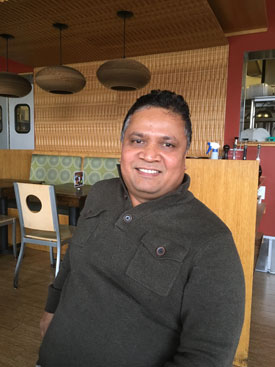
Pankaj Pradhan is the chef and owner of Red Lentil Vegetarian & Vegan Restaurant in Watertown, Massachusetts. (Photo: Bobby Bascomb)
BASCOMB: All right… I think people think vegan food is, you're eating like a rabbit, you know, all you eat is salad. But this, this is the opposite of that. This looks delicious and, and really filling, you know.
PRADHAN: So does that change your opinion about vegan Thanksgiving dinner now?
[LAUGHS]
BASCOMB: Well, I mean, you know, I'm on board, I'm on board. I do like mashed potatoes and gravy and turkey and all that. But uh, you know, I'm open minded for sure.
PRADHAN: So that's a good start for now. [LAUGHS]
BASCOMB: But, um... I'm going to have a bite. ... Mmm. It's really good. The seitan is actually really meaty, like it's chewy.
PRADHAN: Yes, meat substitute, yes.
BASCOMB: Like tofu is more mushy than this, you know.
PRADHAN: Yes it is. And very delicate to cook, tofu.
BASCOMB: I mean it's a lot more nuanced. I mean let's be real. Thanksgiving dinner is delicious, but it's gravy, it’s very heavy, it’s very butter… and this has a lot of nuance.
PRADHAN: Well, the good thing about you being a vegan is, you got to try all the spices. You are not very limited just to steak sauce.
BASCOMB: It seems like being vegetarian or specifically being vegan, it forces you to be more creative.
PRADHAN: Yes, it does.
BASCOMB: So let's try the calamari now too… [CHEWS] It's really good! It's chewy, not nearly as chewy as calamari, but I think that's a good thing. [LAUGHS]
PRADHAN: You have to have a perfect timing to fry the calamari. When you over fry it, it gets rubbery, chewy. Same thing with the mushrooms.
BASCOMB: Um, and so we have this delicious dinner, but I mean Thanksgiving typically ends with pie, a lot of pie – pumpkin pie, apple pie, which is of course made with butter in the crust and the pumpkin pie is made with eggs and milk, condensed milk. What do you do for dessert here?
PRADHAN: We have substitute for everything. We have all kind of binding agents which are taken out from the trees, taken out from the flowers, taken out from the greens. So we don't have to use eggs anymore. I'll give you my secret for this year. I'm making a, since it's Thanksgiving, you have to have something with pumpkin. So I'm making a chocolate pumpkin mousse cake. And the other one which I am doing will be the upside down apple tart, you have to have a tart on Thanksgiving.
BASCOMB: Well it sounds great. It kind of makes me wish I was coming here for dinner. [LAUGHS]
PRADHAN: Hey, you always welcome to come here anytime.
BASCOMB: Well thank you so much for showing me around and giving me some ideas for a vegan Thanksgiving.
PRADHAN: You are welcome.
Related link:
Red Lentil Restaurant Website
[MUSIC: Symphony No. 6 “Pastoral”: 1st movement, Ludwig van Beethoven, CSR Symphony, Michael Halasz, conductor]
CURWOOD: Living on Earth is produced by the World Media Foundation. Our crew includes Naomi Arenberg, Paloma Beltran, Thurston Briscoe, Jenni Doering, Jay Feinstein, Merlin Haxhiymeri, Don Lyman, Lizz Malloy, Isaac Merson, Aynsley O’Neill, Jake Rego, Anna Saldinger, and Jolanda Omari.
BASCOMB: Tom Tiger engineered our show. Alison Lirish Dean composed our themes.
Special thanks this week to Destination Wildlife. You can hear us anytime at loe.org, iTunes and Google play- and like us, please, on our Facebook page - PRI’s Living on Earth. We tweet from @livingonearth. And find us on Instagram at livingonearthradio. I’m Bobby Bascomb.
CURWOOD: And I’m Steve Curwood. Thanks for listening!
ANNOUNCER: Funding for Living on Earth comes from you, our listeners, and from the University of Massachusetts, Boston, in association with its School for the Environment, developing the next generation of environmental leaders. And from the Grantham Foundation for the protection of the environment, supporting strategic communications and collaboration in solving the world’s most pressing environmental problems. Support also comes from the Energy Foundation, serving the public interest by helping to build a strong, clean, energy economy.
ANNOUNCER 2: PRI, Public Radio International.
Living on Earth wants to hear from you!
Living on Earth
62 Calef Highway, Suite 212
Lee, NH 03861
Telephone: 617-287-4121
E-mail: comments@loe.org
Newsletter [Click here]
Donate to Living on Earth!
Living on Earth is an independent media program and relies entirely on contributions from listeners and institutions supporting public service. Please donate now to preserve an independent environmental voice.
NewsletterLiving on Earth offers a weekly delivery of the show's rundown to your mailbox. Sign up for our newsletter today!
 Sailors For The Sea: Be the change you want to sea.
Sailors For The Sea: Be the change you want to sea.
 The Grantham Foundation for the Protection of the Environment: Committed to protecting and improving the health of the global environment.
The Grantham Foundation for the Protection of the Environment: Committed to protecting and improving the health of the global environment.
 Contribute to Living on Earth and receive, as our gift to you, an archival print of one of Mark Seth Lender's extraordinary wildlife photographs. Follow the link to see Mark's current collection of photographs.
Contribute to Living on Earth and receive, as our gift to you, an archival print of one of Mark Seth Lender's extraordinary wildlife photographs. Follow the link to see Mark's current collection of photographs.
 Buy a signed copy of Mark Seth Lender's book Smeagull the Seagull & support Living on Earth
Buy a signed copy of Mark Seth Lender's book Smeagull the Seagull & support Living on Earth

